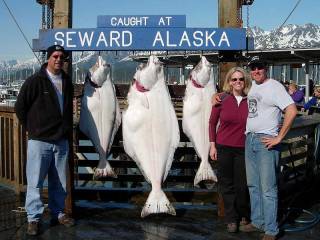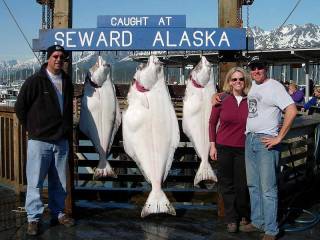 If you’ve ever embarked on a fishing trip to Alaska, then you’ve undoubtedly had the exciting opportunity to fish for the region’s highly-sought species that roam the frigid north. When most people picture fishing in Alaska, their minds quickly associate it with salmon. However, there is another challenging, and delicious, species that lurks near the bottom of the icy waters: halibut.
If you’ve ever embarked on a fishing trip to Alaska, then you’ve undoubtedly had the exciting opportunity to fish for the region’s highly-sought species that roam the frigid north. When most people picture fishing in Alaska, their minds quickly associate it with salmon. However, there is another challenging, and delicious, species that lurks near the bottom of the icy waters: halibut.
The first thing that you’ll notice when you look at a halibut is that there’s something a little different about the fish. No, it’s not an optical illusion. This flat-bodied species’ eyes rest entirely on the brown, “top”, portion, while its underbelly is a pale white. This coloration allows the bottom-dwelling fish to blend into the ocean floor, and when seen from below, blend into the sky above due to its white underside. On average, halibut grow to around 25-20 pounds, but there have been reports of halibut as large as 750 pounds caught.
Near the top of their ecosystem’s food chain, halibut will prey on anything they can swallow, including octopi, salmon, crab, cod, and most organisms found among the rocky ocean floors. In fact, their only predators are large sea lions, killer whales, sharks, and, of course, fishermen.
Fishing for halibut isn’t difficult, but does require strength, endurance, and much heavier tackle then most are used to. Heavy vertical jigging rods, equipped with 80-150 pound test line are needed, as well as large circle hooks to ensure a solid and secure hook set. Bait used to entice halibut often includes herring, very large jigs, or even pieces of large fish–the heads of salmon–for example. It takes a great amount of stamina and determination to muscle these large fish from their deep habitats all the way to the boat, and anyone with health problems that prevent such a strenuous endeavor may want to sit this one out. After all, while it’s exciting to fight such a large fish, it’s more important to stay healthy and come home at the end of the day.
Since halibut are almost always caught to be eaten, common practice is to kill larger specimens once they’re brought to the boat, as it reduces the fish’s suffering and makes landing them much easier.
Should you decide to fly into a remote Alaskan lodge or any other spot among the state’s majestic coast, I challenge you to take on the mighty halibut. It takes a truly dedicated angler to exhibit the patience and skill needed to fight these large fish from the murky depths to the boat and the fight is something you won’t forget for the rest of your life. Take lots of pictures, warm clothes, and, if you’re lucky enough to catch a few, come back soon to catch my recipes and round out your Alaskan trip with a great meal on the table.








